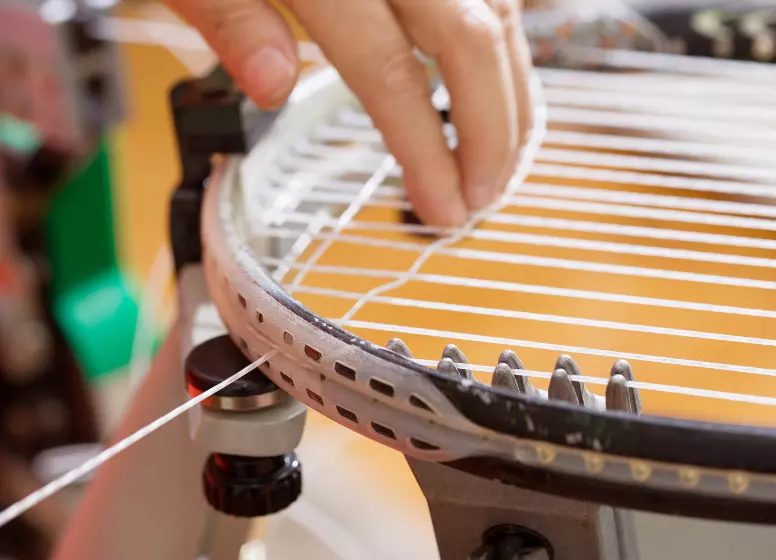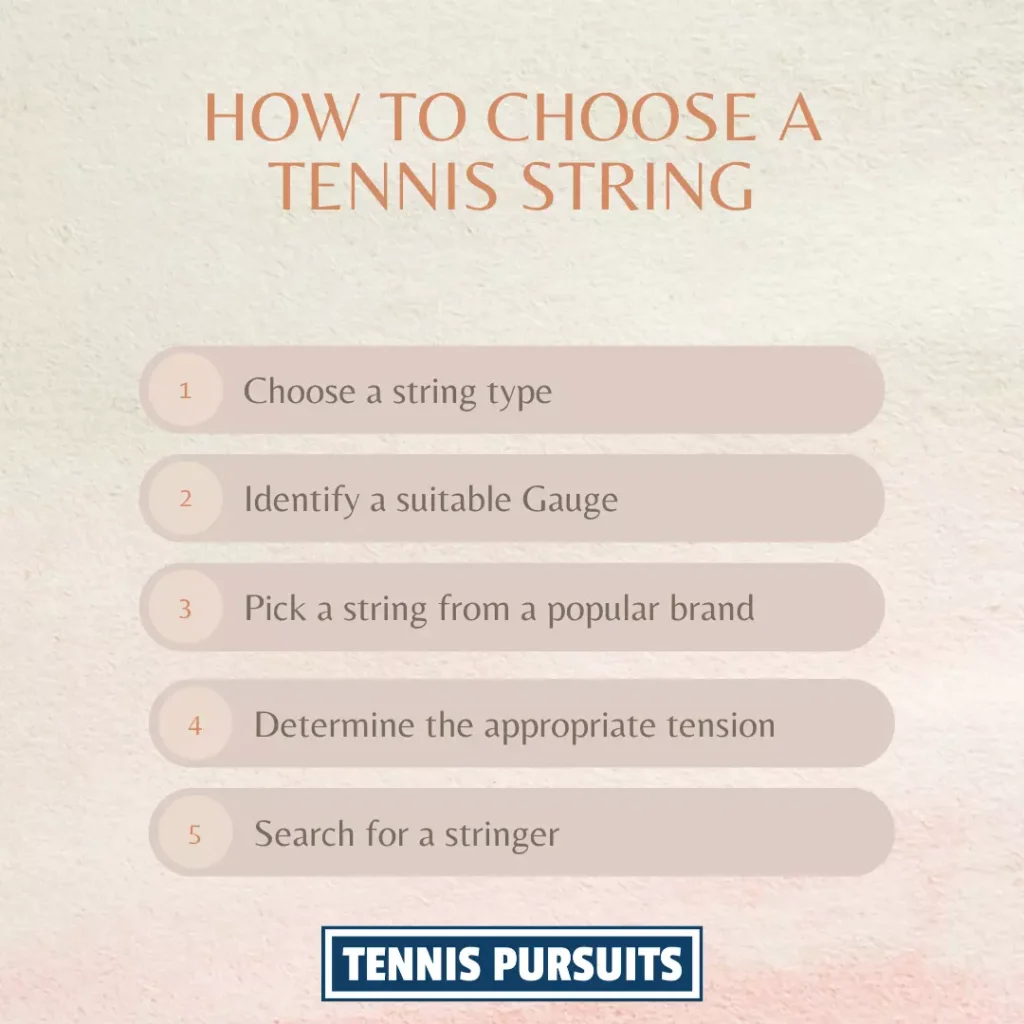It might not seem important, but the strings in your racket have a big impact on how you play. It is for this reason that the strings on tennis rackets are often overlooked by most players. The team here thought it worth writing an article to explain the different types of string and how to choose tennis strings so you can get the most out of your racket. Whatever you need, we’ve got you covered when it comes to the best string, whether it’s your first set or you’re keen to switch to something new.
Understanding Tennis Strings
Before discussing how to choose tennis strings, we’ll need to understand there are many different strings. Tennis strings come in two types, natural gut, and synthetic strings (sometimes referred to as polyester tennis strings). Natural gut strings are made of cow’s or sheep’s intestines, and synthetic strings are made of polyester, nylon, or a combination of materials.
In terms of playability, feel, and power, natural gut strings are known for their playability, while synthetic strings are known for their durability and control. Despite being more expensive, natural gut tennis string tend to last less time than synthetic strings. Synthetic strings, on the other hand, are more affordable and last longer than natural gut strings.
You may enjoy reading Best Tennis Strings for Spin
Do Tennis Strings Really Matter?

Yes, absolutely. When you use the right strings, you can ensure you are performing at your best, improving the health and longevity of your arms, and staying within your budget.
Though changing your strings will have a limited effect, customizing and finding the right fit is worthwhile. A string that maximizes control and spin potential, for example, will perform better than another.
Strings will have a lesser impact on your overall performance early in your tennis career. How well you play will be determined primarily by your technique and repetition. When you become a more advanced player you will want to choose the right tennis strings to suit your game.
How to Choose a Tennis String: 5 Steps

Back when Rod Laver and Margaret Court were winning Grand Slams, they not only had wooden rackets but very limited choices of strings. Strings were exclusively natural gut. Today the market for strings is vast and keeps growing as new products are developed. It can be overwhelming to choose a tennis string when there are so many options available. Read on and we’ll try and help make sense of it all.
Let’s take a quick look at some options:
- If you can ask the advice of a professional / tennis coach/shop owner
- Choose a string type
- Identify a suitable gauge
- Pick a string from a popular brand
- Determine the appropriate tension
- Search for a stringer
We often get a question from new players before we get started, so let’s address that first.
How Important Are Tennis Strings?
It is like anything in life, having a decent saw will make it easier to saw wood. Having a decent paintbrush will make a paint job look better and it is the same with strings – having the right strings can help you improve your game and also look after your arm’s health and longevity.
There is a limit to how much effect changing your strings will have, but customizing and finding the right fit is definitely worthwhile. The performance of certain strings will vary depending on your goals, such as maximizing control and topspin.
The strings you use early in your tennis career will have less effect on your performance. You will be able to play well by using proper technique and practicing.
Through this guide, we’ll cover several topics that will help guide you to the right path. After you purchase your new set of strings, there are a few things you need to consider.
Tips for Success: It’s hopefully already in your bag or you’re already using one that fits your level and style of play, feels comfortable, and feels right for you. It would be a good place to start if you don’t already have one.

So, let’s get started;
Step 1: Choose a string type
Natural gut and synthetic strings are the two major categories of tennis strings you’ll have to decide between when purchasing tennis strings.
Synthetic gut strings are made from artificial materials, while natural gut strings are made from organic fibers.
Strings made of synthetic materials are commonly made from nylon and polyester. A small selection of Kevlar strings is also available, but these aren’t as popular now as they once were.
Natural Gut Tennis Strings
Due to their higher price, natural gut strings are less attractive to most players.
Pierre Babolat first created this type of string from sheep gut in the 1870s. Nowadays, cow intestine is used to make modern natural gut strings.
Due to the molecular structure of natural gut strings, they are extremely elastic, which makes them powerful, comfortable, and comfortable to play with.
It might seem like a no-brainer for some to opt for natural gut strings, but they have drawbacks, including high costs and limited durability.
For experienced players who don’t overly care about the durability of their strings, natural gut strings are a great option.
These strings would not be appropriate for beginners, casual players, or people on a tight budget. You might as well save yourself the money if you’re a beginner or casual tennis player who can’t discern the nuanced difference between synthetic and natural balls.
You may enjoy reading Best Tennis Bags
Synthetic Tennis Strings
There are many types of synthetic strings to choose from, making them the ideal choice for most tennis players. It must be noted, however, that not every string in this category is equal; each has its own pros and cons.
Several synthetic string options are available to you if you choose synthetic strings. The most popular ones are listed below.
Synthetic Gut
Synthetic gut nylon strings are an affordable option for beginners, intermediate players, and recreational players. Nylon strings are generally installed on off-the-shelf racquets that have been pre-strung before sale.
The majority of nylon strings are constructed with a solid core and a smaller outer wrap. There are many factors that determine the price of nylon, such as its quality, exact construction, bonding agents, and coatings.
The low cost and all-around performance of synthetic gut strings make them a good choice for beginners and intermediate players. Casual or recreational players who don’t care as much about string performance and want a cheaper option should go for this option.
Polyester Strings
You’ll find more options in this string category than any other on the pro tour, and polyester strings are becoming increasingly popular.
Due to their durability and stiffness, these low-powered strings allow players to generate more topspin without losing control. Furthermore, the topspin is further enhanced when the strings deform after being struck with enough force.
One of the biggest downsides of these strings can be the stiffness. They also require frequent replacement because they don’t keep tension as well.
Multifilament Strings
An ultra-small nylon fiber is wrapped together to form a single multifilament string. In order to mimic the power, comfort, and feel of natural gut, their construction tends to hold tension better than synthetic gut.
Likewise, what makes them great also makes them hard to control and lack the topspin that many players desire, making them both great and bad.
Final Thoughts
Strings with multifilament technology provide excellent feel at an affordable price for beginners, intermediate players, and advanced tennis players. You’ll appreciate the comfort these strings offer if you’ve had arm injuries in the past.
Kevlar Strings
In the construction of Kevlar strings, aramid fibers are used in order to make them the strongest and stiffest strings available. The strings are a great option if you break your strings frequently.
As a result, they are less popular because of their harsh feel, which may cause arm injuries.
In order to increase the life of your strings, you may want to experiment with Kevlar if you’re a chronic string breaker! Personally, I am not a fan of this string, I find it too tough and struggle with touch on my volleys.
It’s recommended you install one type of string in the mains and another type in the crosses, as part of a hybrid string setup (more on this later).
You may enjoy reading How to Sleep with Tennis Elbow
Step 2: Identify a suitable Gauge
You should have been able to find the right tennis string for you in step one based on your performance and level. The following are the options you would have chosen:
- Natural gut
- Synthetic gut
- Multifilament
- Polyester
- Kevlar
In the next step, you’ll need to choose a gauge that is appropriate for your project. Gauge refers to a string’s size or thickness, more specifically, its diameter or thickness in tennis.
Higher gauges refer to thinner strings, while lower gauges refer to thicker strings in the US. The opposite is true for international gauges.
In the United States, 22 gauges or 2.5 international gauges are the thinnest. The thickest gauge in the United States, on the other hand, is 13 or 12 if you’re following international standards. Approximately 0.60 to 1.65 millimeters correspond to the measurements.
There are some strings on the market that are only available in one size, so this wide range of string gauges won’t be available to everyone.
| United States Gagues | International Gauges | Measurements |
| 13 | 12 | 1.65 – 1.80 mm |
| 14 | 11 | 1.50 – 1.65 mm |
| 15 | 9.5 | 1.41 – 1.49 mm |
| 15L | 9 | 1.33 – 1.41 mm |
| 16 | 8.5 | 1.26 – 1.34 mm |
| 16L | 8 | 1.22 – 1.30 mm |
| 17 | 7.5 | 1.16 – 1.24 mm |
| 18 | 7 | 1.06 – 1.16 mm |
| 19 | 4 | 0.90 – 1.06 mm |
| 20 | 3.5 | 0.80 – 0.90 mm |
| 21 | 3 | 0.70 – 0.80 mm |
| 22 | 2.5 | 0.60 – 0.70 mm |
When all other factors are equal, thicker strings will be more durable, while thinner strings will generate more topspin because they dig deeper into the ball.
The majority of tennis players at the beginning of their careers will have a difficult time detecting the subtle differences between gauges when it comes to topspin performance.
The 16 gauge string is widely available for most strings, so beginners should start with something roughly in the middle.
You’ll choose a string gauge based on your preference at the end of the day. For durability and spin, you can gradually increase or decrease thickness as your skills improve.
Step 3: Pick a string from a popular brand
This is the point when you should be thinking about which type of string to use, as well as what gauge you want to try out. Choosing a string is the fun part.
For every type of string we’ve covered, we’ve compiled our favorites from top tennis brands. As well as gauges, we have listed those as well, since they are available in different gauges.
Select one of the three strings we’ve rounded up based on the type of string you’ve selected below. Tennis isn’t as complicated as it seems if you’re new to it. We’ve selected only the best-in-class strings, so you can rest assured that whatever you choose will be a great choice.
Step 4: Determine the appropriate tension
It’s almost the end of your tennis string selection process, but there are still a few things to consider, starting with tension.
When your strings are attached to your racquet, string tension measures how tightly they’re pulled. Around the world, string tension is measured in kilograms, not pounds. In the United States, string tension is measured in pounds.
It is common to find string tensions ranging from 35 to 70 pounds or 15.88 to 31.75 kilograms. Power is increased when the tension is lower, while control is increased when the tension is higher.
There are many choices to choose from, but you can narrow them down easily. A tennis racquet with a recommended tension range listed on the inside edge of the frame, for example, 50-60 pounds or 23-27 kilograms, is considered premium.
If you choose strings, you should also check their package. There are sometimes recommended tension ranges, which are usually in line with your racquet’s acceptable range.
Beginners should start at the halfway point and split the difference. Our example above suggests 55 pounds as a good weight. Depending on your preferences, you can increase or decrease the tension once you’ve experienced hitting at that tension.
You’ll want to consider this when switching between different types of strings since some strings, such as polyester, perform well at lower tensions.
You may enjoy reading Best Tennis Rackets for Beginners
Step 5: Search for a stringer
The final step is to find someone to string your tennis racquet. You should be almost ready to go at this point.
Most people will find a stringer at their local tennis club or shop, but there are many places to find one. Depending on where you live, they may be a great option for you.
Some sporting goods stores offer string services, so you might want to inquire at your local big box store. If you hire someone to string your violin, make sure they are well qualified for the task.
In addition, RacquetTech’s directory of stringers can provide you with a local tennis coach or instructor who offers stringing services.
Hopefully, you are now all set, but we have included a few other topics that we think will be helpful.
Tennis string replacement
You will lose tension as soon as you start playing with your strings after installation. Likewise, they will lose their resilience and become “dead” over time, indicating that they have lost their elasticity and are no longer functional.
The first 24 hours after string installation can lead to strings losing as much as 10% of their tension. It’s not much of an issue for professional tennis players who have their rackets strung before their matches. To perform at our best, the rest of us must pay attention to our strings.
To find out how often you should string per year, take the number of times you play per week and double it. Stringing your racquet six times a year or every two months is recommended if you play three times a week.
In spite of the method’s imperfections, we find it to be a reliable method for most players to get into the right ballpark. In this case, you can adjust your play based on factors such as the duration of play and the level of aggression you strike the ball with. We recommend replacing your strings every two years at the very least.
Keeping an eye on the feel of your racquet and checking your strings for visual cues can help you determine when it’s time to change them. It’s probably time to rest your strings if they form deep notches on their cross-sections, fray, and look like they’re on their last legs. You can also determine when it’s time to string your violin by noticing a loss of control, spin, or crisp feel.
The best thing you can do is restring your strings before they break.
String Savers
You may still encounter string savers in use today, even though they’re not as popular as they used to be.
Plastic string savers are installed at the breaks between strings in order to protect them from wear and tear.
The friction caused by hitting a ball causes your strings to rub against one another, which can lead to premature breakage. Installing string savers will protect and extend the life of your strings if they break at the same locations repeatedly.
There is some debate about whether string savers deaden the sound of your strings, similar to when you add vibration dampeners.
Additionally, they increase the tension of your strings slightly. You’ll need to decrease your tension by a few pounds if you decide to use string savers but want to keep the same tension.
In spite of the fact that professional players often replace their strings, some still choose to use string savers because they prefer the way they feel. Roger Federer and Grigor Dimitrov are two players who have used them for years. A well-known user of them was Pete Sampras.
The cost of trying them is very low, so you might benefit from them. You can also uninstall string savers without having to replace your strings if you don’t like the way they feel.
You may enjoy reading Best Tennis Shorts
Concept of Hybrid Stringing
The concept of hybrid stringing is gaining popularity among professional and advanced players as they seek to find the perfect set of tennis strings.
When hybrid stringing is implemented, one type of string is installed in the mains and another type of string is installed in the crosses. A multifilament string is combined with a polyester string to provide the comfort and durability of both strings.
A hybrid racquet can contain any combination of two strings, but the following configurations are the most common:
- Natural gut and polyester
- Multifilament and polyester
- Synthetic gut and polyester
For the mains, whichever string you choose will determine the overall performance and feel.
Frequently Asked Questions
What is the best tennis string for beginners?
In order to maximize power and forgiveness, beginners should opt for thicker strings with lower tension.
What is the difference between natural gut and synthetic strings?
A natural gut string provides playability and feel, while a synthetic string ensures durability and control.
How often should I restring my tennis racket?
It is a good idea to restring your tennis racket every 30 hours of play or every three months at the very least. You don’t want to be playing with strings that are about to break!
What are hybrid strings?
Hybrid strings are a combination of two different types of tennis strings.
Can the stringing pattern affect my game?
Yes, you can be affected by the stringing pattern. Power and spin are provided by open string patterns, while control and durability are provided by closed string patterns.
What do the pros use?
Top Professional players increasingly use a combination of natural and synthetic string.
- Roger Federer / String Type: Wilson Natural Gut/Luxilon Big Banger All Power Rough
- Rafael Nadal / String Type: Babolat RPM Blast
- Novak Djokovic / String Type: Babolat VS Team Natural Gut/Luxilon Big Banger Alu Power Rough
Final Thoughts
The type of racket you use is important and your strings are the only part of your racket that touches the ball when you hit, so don’t underestimate the importance of them.
Choosing the right string can improve your performance, increase your level of play, and save you money, but it won’t make up for years of practice and hard work (you don’t get away with it that easily!!)
We advise you to experiment with different types of tennis strings, gauges, and tensions in order to get a feel for the nuances of each, and by trial and error, you will work out which tennis racket strings are the best choice for you. Ultimately it is down to personal preference.
You may enjoy reading What’s The Best Tennis Racket For Me in 2024? Take Our Quiz To Find Out – Tennis Pursuits





Comments are closed.